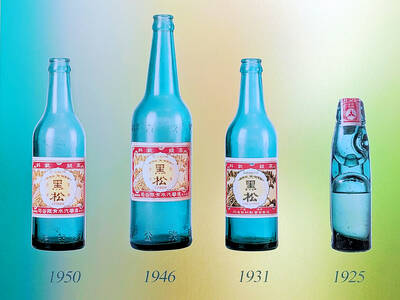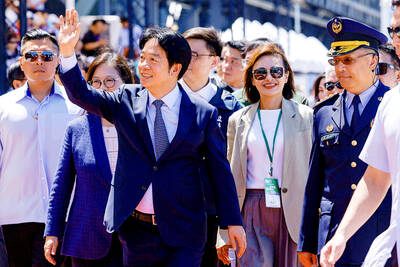Following last Sunday’s historic Prague speech by US President Barack Obama envisioning a world free of nuclear weapons, no classical work could currently make more appropriate viewing than US composer John Adams’ most recent opera, Doctor Atomic, issued on DVD by Opus Arte last year.
It features the run-up to the testing of the atom bomb in the New Mexican desert on July 16, 1945. At its center is J. Robert Oppenheimer, the cultured but troubled scientist who led the project. But Oppenheimer isn’t shown as a modern Faust figure, selling his soul to the devil in exchange for knowledge, but something more modern — a short-tempered neurotic opposed by invocations to Vishnu, Native American rain dances, and extensive poetic quotations that are used as backdrop to the whole hideous story.
And it is presented as hideous. The subsequent bombings of Hiroshima and Nagasaki are prefigured early on by a discussion of the US’ decision to select targets with a high concentration of workers’ houses, and not to give Japan any advance warning. And a half-hour interview with director and librettist Peter Sellars, the most extensive of several bonus items, makes no bones about the work’s essential meaning.
Art cannot parallel the unspeakable horrors of Hiroshima and Nagasaki, he says. But the continued existence of these weapons, all subject to possible accidental or deliberate use, and last year on the back burner of public awareness, is at the heart of Doctor Atomic. It was Sellars himself who assembled the libretto, a montage of recently declassified documents, Native American prayers, and poems by, among others, Baudelaire, John Donne and the 1930s pacifist and feminist Muriel Rukeyser.
Doctor Atomic is Adams’ third opera on a politically charged theme, following The Death of Klinghoffer (1991) on the hijacking of the Achille Lauro cruise ship by Palestinian terrorists in 1985, and Nixon in China (1987). It was initially a co-production of the San Francisco Opera, the Lyric Opera of Chicago and the Nederlandse Opera in Amsterdam, and this DVD was put together from Amsterdam performances given in June 2007. It has subsequently received a different production from the Metropolitan Opera, New York, as well as being staged by the English National Opera in London.
Adams’ music is particularly suitable to opera. It’s far more dramatic, for example, than Philip Glass’ operatic writing, mesmerizing though that often is. There are no melodies as such, but in their place Adams uses just about everything he can find — sirens, bells, computer-generated sounds — with rhythms that surge onwards, and counter-rhythms that flicker back and forth underneath. It’s a style that reinforces the fundamental drama, as well as the intensity of the characters’ feelings. Its success becomes even clearer once one begins to realize just how inappropriate to the subject matter melodies would actually be.
You’d think that a libretto such as Sellars provides, lacking conventional dialogue, would inhibit characterization. But this isn’t the case. Many strongly delineated characters emerge — the ruthless general Leslie Groves (Eric Owens), the scientist Edward Teller (Richard Paul Fink), the dissident scientist Robert Wilson (Thomas Glenn), the Oppenheimers’ Tewa Indian maid Pasqualita (Ellen Rabiner) and, most impressive of all, Opperheimer’s wife Kitty (Jessica Rivera).
Gerald Finley has made the role of Oppenheimer his own — he’s sung it in all the productions so far. With his broad-brimmed hat and relentless drawing on cigarettes, he isn’t the cultured polymath who was proficient in six languages including Sanskrit. Instead, he’s a nervous, authoritarian figure whose tense physical presence covers a repressed emotional and imaginative life. The implication is that it’s these tense, over-rationalistic figures who now pose the greatest threat to mankind that it has ever known.
The inner Oppenheimer, however, is revealed in two scenes. One is where he’s making love to his wife, who is quite as much a mother-goddess figure as Pasqualita, both distrusting the catastrophic interference with nature by the males of the piece. And another is where he pours out John Donne’s sonnet Batter My Heart, Three-Person’d God as an act-concluding solo aria.
The stage picture features from time to time the New Mexico skyline, the bomb with its maze of exterior wires suspended center-stage, the Oppenheimers’ living-quarters, and a variety of scientific controls with their knobs, dials, flashing lights and T-shirt-clad attendants. The uncertain weather (a historical fact), with its fast-moving clouds and flashes of lightening, adds to the drama.
The opera is characterized by continual interest. There are dancers, for instance, rare in a Sellars production, and here often looking like people fleeing in panic. And somehow all the disparate elements — the found texts and the eclectic music — manage to cohere into an exceptionally persuasive whole.
The text, shown sometimes at the bottom of the screen and sometimes at the top, is available in English, French, German, Spanish, Italian and Dutch, and there are many short bonus items featuring Adams, the Amsterdam rehearsals, the main soloists (who introduce themselves), as well as the long interview with Sellars.
Is this, then, a contemporary masterpiece? Yes, quite possibly. So when will we be seeing a production in Taiwan? Probably not any time soon. The opera being offered this summer by the National Symphony Orchestra is Carmen, albeit in an apparently strong new production.

The unexpected collapse of the recall campaigns is being viewed through many lenses, most of them skewed and self-absorbed. The international media unsurprisingly focuses on what they perceive as the message that Taiwanese voters were sending in the failure of the mass recall, especially to China, the US and to friendly Western nations. This made some sense prior to early last month. One of the main arguments used by recall campaigners for recalling Chinese Nationalist Party (KMT) lawmakers was that they were too pro-China, and by extension not to be trusted with defending the nation. Also by extension, that argument could be

Aug. 4 to Aug. 10 When Coca-Cola finally pushed its way into Taiwan’s market in 1968, it allegedly vowed to wipe out its major domestic rival Hey Song within five years. But Hey Song, which began as a manual operation in a family cow shed in 1925, had proven its resilience, surviving numerous setbacks — including the loss of autonomy and nearly all its assets due to the Japanese colonial government’s wartime economic policy. By the 1960s, Hey Song had risen to the top of Taiwan’s beverage industry. This success was driven not only by president Chang Wen-chi’s

Last week, on the heels of the recall election that turned out so badly for Taiwan, came the news that US President Donald Trump had blocked the transit of President William Lai (賴清德) through the US on his way to Latin America. A few days later the international media reported that in June a scheduled visit by Minister of National Defense Wellington Koo (顧立雄) for high level meetings was canceled by the US after China’s President Xi Jinping (習近平) asked Trump to curb US engagement with Taiwan during a June phone call. The cancellation of Lai’s transit was a gaudy

The centuries-old fiery Chinese spirit baijiu (白酒), long associated with business dinners, is being reshaped to appeal to younger generations as its makers adapt to changing times. Mostly distilled from sorghum, the clear but pungent liquor contains as much as 60 percent alcohol. It’s the usual choice for toasts of gan bei (乾杯), the Chinese expression for bottoms up, and raucous drinking games. “If you like to drink spirits and you’ve never had baijiu, it’s kind of like eating noodles but you’ve never had spaghetti,” said Jim Boyce, a Canadian writer and wine expert who founded World Baijiu Day a decade